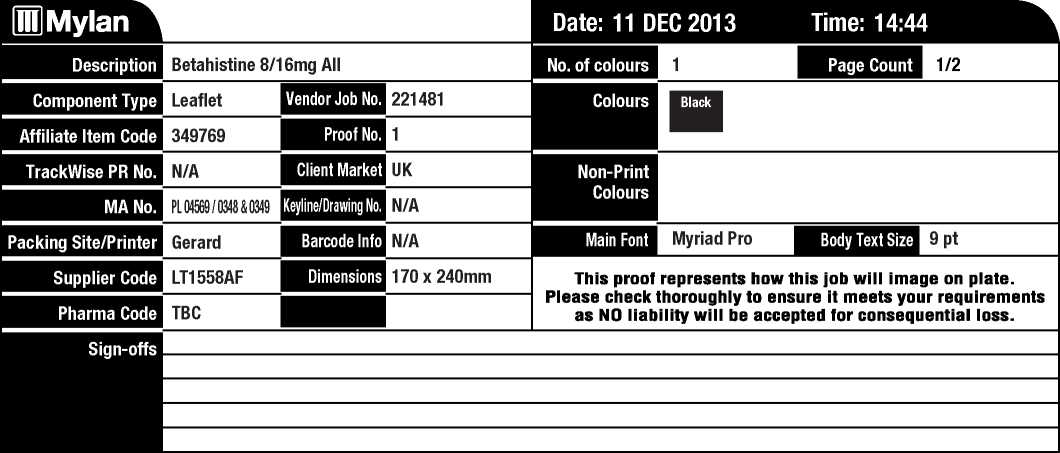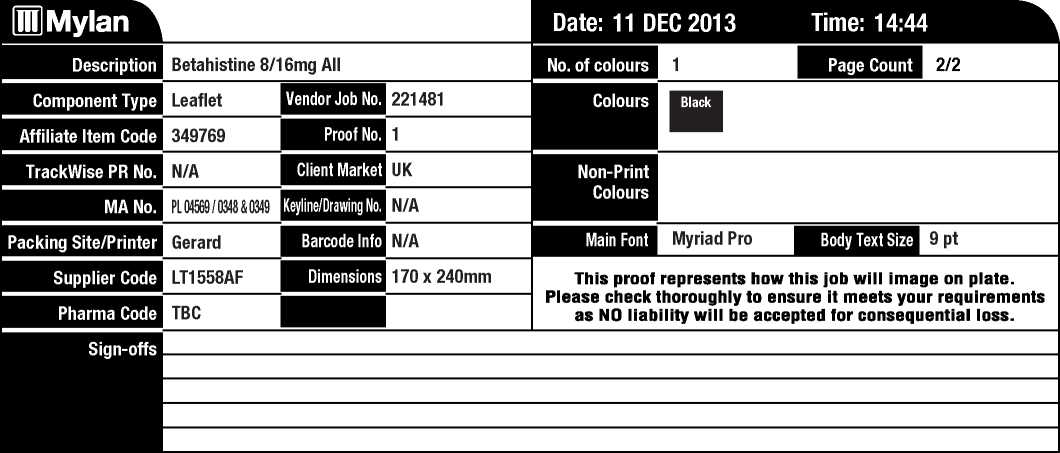Betahistine Dihydrochloride 16Mg Tablets
Read all of this leaflet carefully before you start taking this medicine because it contains important information for you.
• Keep this leaflet. You may need to read it again.
• If you have any further questions, ask your doctor or pharmacist.
• This medicine has been prescribed for you only. Do not pass it on to others. It may harm them, even if their signs of illness are the same as yours.
• If you get any side effects, talk to your doctor or pharmacist. This includes any possible side effects not listed in this leaflet. See section 4.
=CO=
What is in this leaflet:
1. What Betahistine is and what it is used for.
2. What you need to know before you take Betahistine.
3. How to take Betahistine.
4. Possible side effects.
5. How to store Betahistine.
6. Contents of the pack and other information.
1. WHAT BETAHISTINE IS AND WHAT IT IS USED FOR
Betahistine belongs to a group of medicines known as histamine analogues. It works by improving blood flow in the inner ear, which reduces the build up of pressure. It is this pressure in the inner ear which is thought to cause nausea, vertigo (dizziness), tinnitus (ringing in the ears) and hearing loss suffered by people with Meniere's disease. Betahistine is used in the treatment of these symptoms.
2. WHAT YOU NEED TO KNOW BEFORE YOU TAKE BETAHISTINE
Adults (including the elderly):
The usual starting dose is one or two 8 mg tablets or one 16 mg tablet three times a day.
The maintenance dose is usually in the range 24 and 48 mg daily.
PACKAGE LEAFLET: INFORMATION FOR THE PATIENT
BETAHISTINE DIHYDROCHLORIDE 8 mg TABLETS
BETAHISTINE DIHYDROCHLORIDE 16 mg TABLETS
(betahistine dihydrochloride)
Do not take Betahistine:
• if you are allergic to betahistine dihydrochloride or any of the other ingredients of this medicine (listed in section 6)
• if you are taking an antihistamine to treat allergy. Betahistine may lower the effect of antihistamines.
• if you have a tumour of the adrenal gland called a phaeochromocytoma.
Warning and precautions
Talk to your doctor or pharmacist before taking
this medicine:
• if you suffer from bronchial asthma
• if you have a peptic ulcer (ulcer in stomach or upper part of the intestine, known as the duodenum), or have ever suffered from peptic ulcers in the past
• if you sometimes have allergic reactions such as hives (urticaria), skin rashes, or itchy or runny nose
• if you suffer from intense dizziness when you move your head in certain directions or dizziness in relation to various conditions related to the brain and spinal cord.
Other medicines and Betahistine
Tell your doctor or pharmacist if you are taking, have recently taken or might take any other medicines.
In particular tell your doctor or pharmacist if you are taking the following medicines:
• salbutamol, to treat asthma
• medicine to treat or prevent malaria e.g. pyrimethamine with dapsone.
• an antihistamine (see section 'Do not take')
• monoamine oxidase inhibitors (MAOIs) - used to treat depression or Parkinson's disease.
These may increase the exposure of betahistine.
Betahistine with food, drink and alcohol You should not drink alcohol while being treated with this medicine, because there have been reported cases of interaction between this medicine with alcohol. Your medicine is best taken with food.
Pregnancy and breast-feeding
Betahistine should not be taken during pregnancy or breast-feeding.
If you are pregnant or breast-feeding, think you may be pregnant or are planning to have a baby, ask your doctor or pharmacist for advice before taking this medicine.
Driving and using machines
Do not drive or operate machinery if you feel dizzy or drowsy, or you have eyesight problems while taking this medicine.
3. HOW TO TAKE BETAHISTINE
Always take this medicine exactly as your doctor has told you. Check with your doctor or pharmacist if you are not sure. Speak to your doctor first before stopping this medicine.
The recommended dose is:
Use in children and adolescents
Betahistine should not be given to children and adolescents under 18 years because there is insufficient information on efficacy and safety.
How to take
Swallow the tablet with a glass of water.
This medicine is best taken with food.
If you take more Betahistine than you should
Contact your doctor or nearest hospital emergency department immediately. Take the container and any remaining tablets with you. Symptoms of overdose include nausea, vomiting, indigestion, sleepiness, stomach pain, difficulty in controlling movements, seizures (fits), lung and heart problems at higher doses.
LT1558AF


If you forget to take Betahistine
Take the next dose as soon as you remember unless it is almost time for your next dose.
Do not take a double dose to make up for a forgotten dose.
If you have any further questions on the use of this medicine, ask your doctor or pharmacist.
4. POSSIBLE SIDE EFFECTS
Like all medicines, this medicine can cause side effects, although not everybody gets them.
If any of the following happen, stop taking Betahistine and tell your doctor immediately or go to your nearest hospital emergency department:
Not known (frequency cannot be estimated from the available data):
• allergic reactions including severe allergic reactions like anaphylaxis; symptoms may include hives (urticaria), rash, itching, difficulty breathing or swelling of the face, lips, throat or tongue, sudden feeling of weakness (drop in blood pressure), unconsciousness.
Other side effects:
Very common (may affect more than 1 in 10 people):
• dry mouth
• diarrhoea.
Common (may affect up to 1 in 10 people):
• headache
• nausea
• indigestion (dyspepsia).
Rare (may affect up to 1 in 1,000 people):
• sleepiness
• a feeling of weakness.
Very rare (may affect up to 1 in 10,000 people):
• a decrease in the number of some blood cells called platelets (these help in the clotting of blood)
• an increase in certain body enzymes (transaminases).
Not known (frequency cannot be estimated from the available data):
• mild gastric complaints such as vomiting, stomach pain and bloating. Taking betahistine with food can help reduce any stomach problems or speak to your doctor in case your dose needs adjusting.
• skin rashes.
Reporting of side effects
If you get any side effects, talk to your doctor or pharmacist. This includes any possible side effects not listed in this leaflet. You can also report side effects directly via Yellow Card Scheme, Website: www.mhra.gov.uk/yellowcard. By reporting side effects you can help provide more information on the safety of this medicine.
5. HOW TO STORE BETAHISTINE
Keep this medicine out of the sight and reach of children.
Do not use this medicine after the expiry date which is stated on the carton and blister foil after 'EXP'.
The expiry date refers to the last day of that month. Keep in the original container to protect from light and moisture.
Do not store above 25°C.
Do not throw away any medicines via wastewater or household waste. Ask your pharmacist how to throw away medicines you no longer use.
These measures will help protect the environment.
6. CONTENTS OF THE PACK AND OTHER INFORMATION
What Betahistine contains
The active substance is betahistine dihydrochloride.
Betahistine Dihydrochloride 8 mg tablets contain 8 mg betahistine dihydrochloride.
Betahistine Dihydrochloride 16 mg tablets contain 16 mg betahistine dihydrochloride.
The other ingredients are cellulose, microcrystalline, mannitol (E421), citric acid monohydrate (E330), silica, colloidal anhydrous, and talc (E553b).
What Betahistine looks like and contents of the pack
Your medicine comes as a round white tablet. The 8 mg tablets are marked 'BH 8' on one side and 'G' on the other. The 16 mg tablets are marked 'BH 16' on one side and 'G' on the other.
Betahistine is available in blister strips in packs of 20, 28, 30, 56, 84, 90, 100, 112, 120, 168 and 180 tablets and also in polypropylene tablet containers in packs of 5, 7, 10, 15, 20, 21,25, 28, 30, 50, 56, 60, 84, 90, 100,
112, 120, 168, 250, 500 and 1000 tablets. Not all pack sizes may be marketed.
Marketing Authorisation Holder
Mylan, Potters Bar, Herts., EN6 1TL, U.K.
Manufacturer
Gerard Laboratories
35/36 Baldoyle Industrial Estate,
Grange Road
Dublin 13
Ireland
Generics [UK] Limited Station Close Potters Bar Hertfordshire EN6 1TL
United Kingdom
This leaflet was last revised in LT1558AF
12/2013. 349769
I
